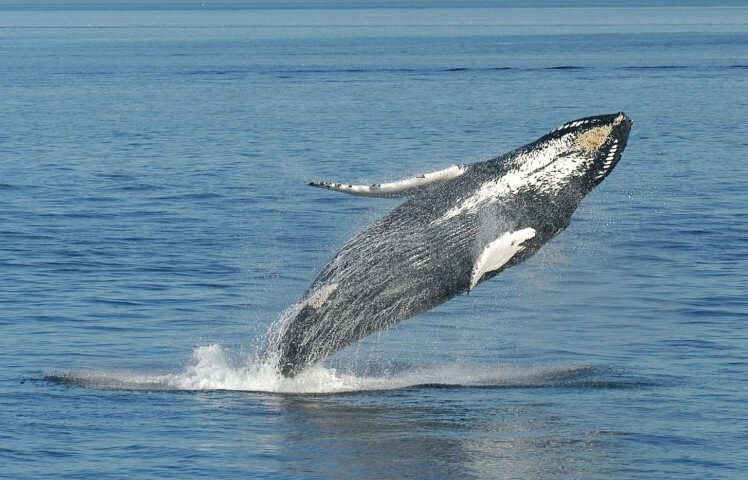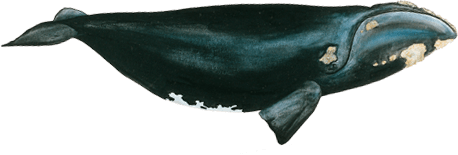Feeding
The humpback whale is a gulper, feeding on planktonic crustaceans (krill) and small schooling fish (herring, capelin, sand lance). It feeds alone or cooperates with other individuals to hunt its prey. By breathing air through their blowholes, a group of whales can create a net or cloud of bubbles to cause panic amongst and trap their prey. Such bubbling techniques are not used everywhere and vary from one ocean to another. These feeding strategies are believed to be transmitted from mother to calf. Feeding techniques can also be passed between adults within a population. The humpback whale sometimes feeds at the surface, readily displaying its gaping mouth, its baleen as well as its gigantic throat expanded using ventral grooves.
On the surface
The humpback is a rather slow moving animal. Its long pectoral fins, serrated and covered in tubers, improve its manoeuvrability and are used for steering and balance. These fins are unique in the animal kingdom and might even inspire engineers for applications for aircraft wings or wind turbine blades! Its aerial behaviour repertoire includes breaching and landing noisily on its back, belly or side (up to 30 times consecutively); slapping the water with its pectoral or caudal fins; and spyhopping with its head held vertical to the surface. Occasionally, some individuals can be very curious toward watercraft. When they dive, humpbacks arch their back and their caudal fin slowly rises vertically into the air. Thus, the underside of the tail is clearly visible and each individual can be easily identified thanks to its pigmentation pattern (predominantly black or white, marks, scars) as well as the shape of the two serrated flukes.
Diving
Dives last 5 to 10 minutes (reaching upward of 30 minutes), and rarely exceed depths of 120 m.
Social
Although mostly solitary, humpbacks are observed in pairs or small rather unstable groups. Of all the rorqual species, humpbacks are the most socially active. In summer, the formation of small groups is believed to be linked to sectors where food is abundant. In the fall, groups are observed during migration. In winter months, more compact groups and even larger gatherings take shape for the reproductive season. In the summer of 2006, 2 second-year juveniles, Pi-rat and Gaspar, spent 6 weeks in the Estuary, often together. Their pairing was more unstable when they returned in 2007, with Pi-rat spending about 10 weeks in the sector compared to 8 weeks for Gaspar.
Vocalization
During the breeding season, males perform long, melodious and complex songs to attract females and certainly to establish dominance amongst competing males who themselves are also exhibiting aggressive behaviours. These highly varied songs are specific to each population. Recent discovery: in the Pacific, when a new song emerges in a group of males, it is imitated from pod to pod. This mode of horizontal cultural transfer takes place from east to west, from one year to the next and within the same generation. Moreover, the results of telemetric monitoring studies conducted in 2007 on humpback whales in the Northwest Atlantic reveal that these individuals emit sound pulse sequences in a wide frequency band in association with nocturnal feeding behaviours. Even if humpback whales vocalize mainly to communicate, they might also use sounds to “read” their environment, get their bearings and identify large targets. These powerful, low-frequency sounds can travel long distances.






